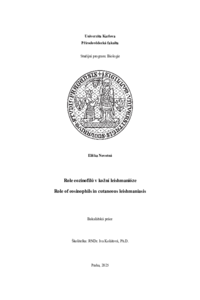Role eozinofilů v kožní leishmanióze
Role of eosinophils in cutaneous leishmaniasis
bachelor thesis (DEFENDED)

View/
Permanent link
http://hdl.handle.net/20.500.11956/199350Identifiers
Study Information System: 263120
Collections
- Kvalifikační práce [20861]
Author
Advisor
Referee
Krulová, Magdaléna
Faculty / Institute
Faculty of Science
Discipline
Biology
Department
Department of Parasitology
Date of defense
4. 6. 2025
Publisher
Univerzita Karlova, Přírodovědecká fakultaLanguage
Czech
Grade
Very good
Keywords (Czech)
eozinofily, infiltrát, kožní leishmanióza, Leishmanie, lézeKeywords (English)
eosinophils, infiltrate, cutaneous leishmaniasis, Leishmania, lesionsTato bakalářská práce se zaměřuje na funkci eozinofilních granulocytů při onemocnění, které se nazývá kožní leishmanióza, což je infekční onemocnění způsobené prvoky rodu Leishmania. Kožní leishmanióza představuje významný zdravotní problém v mnoha tropických a subtropických oblastech, přičemž její patogeneze a obranné imunitní mechanismy nejsou dosud plně objasněny. Klíčovým aspektem popisovaným v této práci je úloha eozinofilů v organismu, a to nejen v procesu imunitní odpovědi na leishmanie, ale i během homeostáze a také popsání metod, jimiž je lze izolovat a následně studovat. Práce se zabývá shrnutím aktuálních článků, které se věnují eozinofilům, jejich tkáňovým formám, obsahu granulí, které jsou nejspíše nejdůležitějším mechanismem efektorových procesů a dále jejich významu proti patogenům všeobecně. Následně jsou popsány přístupy, kterými eozinofily můžeme izolovat z krve či tkáně, čehož se využívá v dalších metodách jejich výzkumu, jako je ELISA, histologie a imunohistochemie, nebo průtoková cytometrie. Stěžejní částí této práce je kapitola týkající se role eozinofilů v kožní leishmanióze, kde jsou shrnuty výsledky výzkumných skupin, které mají rozličné metody přístupu k jejich studiu. Nejčastější je používání in vitro kultivace eozinofilů s promastigoty leishmanií, v některých případech s...
This bachelor thesis focuses on the function of eosinophil granulocytes in a disease called cutaneous leishmaniasis, an infectious disease caused by protozoa of the genus Leishmania. Cutaneous leishmaniasis is a major public health problem in many tropical and subtropical regions, and its pathogenesis and immune mechanisms are not yet fully understood. A key aspect described in this thesis is the role of eosinophils in the organism, not only in the immune response to Leishmania but also during homeostasis, as well as describing methods by which they can be isolated and subsequently studied. The thesis reviews recent articles dealing with eosinophils, their tissue forms, granule content, which is probably their most important effector mechanism, and their importance against pathogens in general. Subsequently, the approaches by which eosinophils can be isolated from blood or tissue are described, which is used in other methods of their research, such as ELISA, histology and immunohistochemistry, or flow cytometry. The main part of this thesis is the chapter on the role of eosinophils in cutaneous leishmaniasis, which summarises the results of research groups that have taken different approaches to their study. The most common is the use of in vitro cultures of eosinophils with Leishmania...
